What is an ICD?
An ICD (implantable cardioverter defibrillator) is an electronic device that constantly monitors your heart rhythm. When it detects a very fast, abnormal heart rhythm, it sends energy to the heart muscle. This causes the heart to beat in a normal rhythm again.
Why is an ICD needed?
Ventricular tachycardia and ventricular fibrillation are two life-threatening heart rhythms that cause the heart to beat very fast. These conditions can be fatal if not treated immediately.
Your doctor has recommended that you receive an ICD because you have had at least one episode of these heart rhythms or are at high risk of developing these types of heart rhythms.
Who needs an ICD?
You may need an ICD if you:
- Have had sudden cardiac arrest.
- Have had ventricular fibrillation.
- Have had at least one episode of ventricular tachycardia.
- Have had a heart attack and are at greater risk of having sudden cardiac arrest or sudden cardiac death.
- Have hypertrophic cardiomyopathy.
Together, you and your doctor will determine if an ICD is the right treatment for you.
ICD device
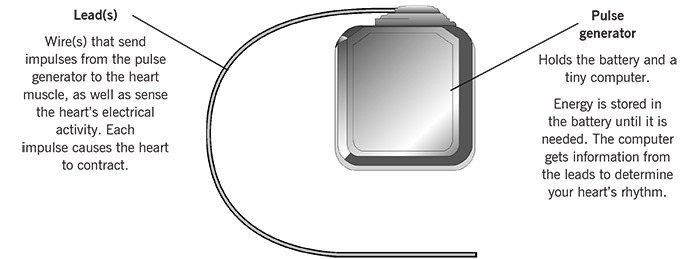
How does an ICD work?
The ICD monitors the heart rhythm, identifies abnormal heart rhythms and gets your heartbeat back into a normal heart rhythm. Your doctor programs the ICD to include one or all of the following functions:
- Anti-tachycardia pacing (ATP) – When your heart beats too fast, a series of small electrical impulses are sent to the heart muscle to restore a normal heart rate and rhythm.
- Cardioversion – A low-energy shock is sent at the same time as your heartbeat to restore a normal heart rhythm.
- Defibrillation – When the heart is beating dangerously fast, a high-energy shock is sent to the heart muscle to restore a normal rhythm.
- Bradycardia pacing – When the heart beats too slowly, small electrical impulses are sent to help your heartbeat return to a faster, more normal rate.
How is an ICD implanted?
An ICD can be put in place in 2 ways:
- Transvenous - The ICD is placed under the skin. The leads (1, 2, or 3) are inserted into a vein and guided to your heart using an X-ray inside the chest.
- Subcutaneous - The ICD is placed under the skin below your underarm area. A single lead is used. It is placed under the skin in your chest area and tunneled from the ICD to the breastbone (sternum), and to the top of the sternum.
Your doctor will talk to you about the best type of ICD for you.
Types of Transvenous ICDs
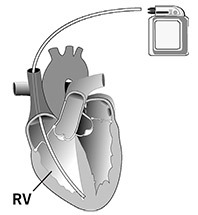
Single chamber ICD
A lead is attached in the right ventricle (RV). If needed, energy is sent to the ventricle to help it contract normally.
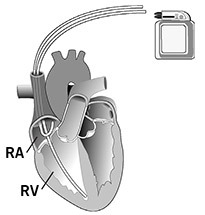
Dual chamber ICD
Leads are attached in the right atrium (RA) and the right ventricle (RV). Energy is sent first to the right atrium and then to the right ventricle, helping your heart to beat in a normal sequence.
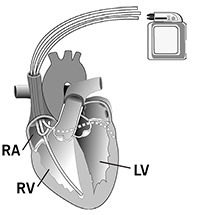
Biventricular device
Two or three leads are placed in the right atrium (RA), the right ventricle (RV) and the left ventricle (LV) through the coronary sinus vein. This device helps the heart beat in a more balanced way and is specifically used for some patients with heart failure.
Is the ICD implant procedure safe?
A device implant is generally a very safe procedure. However, as with any invasive procedure, there are risks. We will do everything possible to reduce the risk of problems. Please talk to your doctor about any concerns or questions you have.
Where is the implant procedure performed?
In most cases, the implant procedure takes place in a special room in the Electrophysiology Lab. If the ICD is put in place using an epicardial approach, the implant is done in an operating room.
Before the Procedure
What time should I be at the hospital?
Call 800.223.2273 between 3 p.m. and 5 p.m.; ask for Pager Number 20353 (the EP scheduling nurse), who will give you an arrival time.
If your procedure is scheduled for a Monday, please call the Friday before. If your procedure is scheduled after a holiday, please call the last business day before the holiday.
Please do not call the Cleveland Clinic Operator or the Admitting Office for information about your procedure. We will let you know about any changes to your schedule.
Should I take my medications?
Ask your doctor if you need to stop taking any medications before your procedure. Do not stop taking any of your medications unless your doctor tells you to.
If you have diabetes, ask the nurse how to adjust your diabetes medications or insulin.
Can I eat before my procedure?
Eat a normal meal the evening before your procedure. But, DO NOT eat, drink or chew anything after midnight the night before your procedure. This includes gum, mints, water, etc.
If you need to take medications, take them with small sips of water. Do not swallow any water when you brush your teeth.
What should I wear?
Do not wear makeup or nail polish.
Wear comfortable clothes when you come to the hospital. You will change into a hospital gown for the procedure.
Leave all jewelry (including wedding rings), watches and valuables at home.
What should I bring?
You will not need a robe or toiletries when you first arrive. You may pack these items and leave your bag with the person who comes with you to the hospital.
Bring a one-day supply of your prescription medications. Do not take these medications without first asking your doctor or nurse.
You may bring an audio player to listen to guided imagery or music.
What happens before the procedure?
A nurse will help you get ready for your procedure. You will change into a hospital gown. You can put your clothes in a locker or give them to a family member/friend.
You will lie on a bed and the nurse will start an intravenous (IV) line in a vein in your arm or hand. The IV is used to give you medications and fluids during the procedure.
To prevent infection:
- You will get an antibiotic through your IV.
- Men: One side of your chest will be shaved.
- We will clean the insertion area.
- We will cover you from neck to feet with sterile coverings (drapes).
- A soft strap may be placed across your waist and arms to keep your hands from touching the sterile area.
Will I be awake during the procedure?
You will get medication through your IV to help you relax and make you feel drowsy, but you will not be put to sleep with anesthesia during the procedure.
Will I be monitored?
Several monitors are used during the procedure to constantly check things like your heart rhythm and blood pressure.
Monitors during the procedure
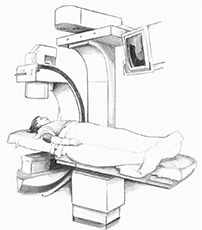
Defibrillator/pacemaker/cardioverter: Attached to one sticky patch placed on the center of your back and one on your chest. This allows the doctor and nurse to pace your heart rate if it is too slow, or deliver energy to your heart if the rate is too fast.
Electrocardiogram (EKG): Attached to several sticky electrode patches placed on your chest. Provides a picture of the electrical impulses traveling through your heart.
Blood pressure monitor: Connected to a blood pressure cuff on your arm. Checks your blood pressure throughout the procedure.
Oximeter monitor: Attached to a small clip placed on your finger. Checks the oxygen level of your blood.
Fluoroscopy: A large X-ray machine will be positioned above you to help the doctors see the leads on an X-ray screen during the procedure.
How is the ICD implanted?

The ICD is usually implanted using the endocardial (transvenous) approach. The implant area is numbed and then small incisions are made in the chest where the lead(s) and device will be inserted.
The lead is inserted through the incision and into a vein, then guided to the heart. A special X-ray machine (fluoroscopy) is used to see the lead as it goes into place. The tip of the lead is attached to the heart muscle, and the other end is attached to the pulse generator. The generator is placed in a pocket created under the skin in the upper chest.
In rare cases when the endocardial approach cannot be used, the epicardial (surgical) approach is used. With this approach, you are put to sleep with general anesthesia. The generator is placed in a pocket created under the skin in the lower abdomen.
Your doctor will determine which is the best implant procedure approach for you.
How are the leads tested?
After the leads are in place, they are tested to make sure they are in the right place and working properly. This lead function test is called pacing. During the test, small amounts of energy are sent through the leads into the heart muscle. This energy causes the heart to contract. You will be asleep for several minutes during the test.
After the leads are tested, your doctor will connect them to the ICD. Your doctor will determine the right rate and settings for the ICD, and the device will be adjusted after the procedure.
What will I feel?
Subcutaneous approach: You will feel a burning or pinching sensation when the doctor injects the local numbing medication. Then, the area will become numb. You may feel a pulling sensation as the doctor makes a pocket in the tissue under your skin for the device. Please tell your doctor about any symptoms you have. You should not feel pain. If you do, tell your nurse right away.
How long does the procedure last?
The device implant procedure may last 2 to 4 hours.
Will I have to stay in the hospital?
Yes. You will stay overnight in the hospital after the procedure. You will probably go home the day after your procedure.
If you had surgery (epicardial approach), you will spend 3 to 5 days in the hospital. If you had minimally invasive surgery your stay and recovery time will be shorter.
After the Procedure
What should I expect during my recovery?
You will wear a telemetry monitor so your healthcare team can watch your heart rhythm on monitors at the nurse’s station. The monitor is a small box with wires that attach to small, sticky patches (electrodes) on your chest.
You will also wear a holter monitor for 12 hours to make sure your ICD is working properly. The monitor records your heart rhythm.
You will have a chest X-ray to check your lungs and the position of the device and lead(s).
Your monitors will be removed, and you will go to the device clinic before you leave the hospital.
What happens at the device clinic?
A nurse will program your ICD to the settings your doctor determined are right for you and make sure the ICD and lead(s) are working. This is done while you sit in a reclining chair. Electrodes will be placed on your chest and connected to a computer. Your nurse will place a small device called a programmer directly over the device. You may feel your heart beat faster or slower as the settings are changed. This is normal, but please tell the nurse what you feel.
Your doctor will get the results of your device check and your holtor monitor recording.
The nurse in the device clinic will go over your home-going instructions, including incision care, activity guidelines and follow-up schedule.
You may have an echocardiogram in the device clinic. If not it will be done during your follow-up appointment.
How will I feel?
You may feel discomfort at the device implant site during the first 48 hours after the procedure. Your doctor will tell you what medications you can take for pain relief. Please tell your doctor or nurse if you have severe symptoms or if they last a long time.
What instructions will I get before I leave the hospital?
Your doctor will talk to you about the results of your procedure and answer any questions you have. Be sure to ask the doctor if you should keep taking the same medications you did before the procedure.
Make sure you understand your home-going instructions, including maintenance of the ICD and your follow-up schedule. You can also refer to the handout, "ICD Discharge Instructions."
ID card
You will get a temporary ID card that tells you what type of device and lead(s) you have, the device manufacturer, the date of the device implant and the name of the doctor who implanted the device. Within 3 months, you will receive a permanent ID card from the device company. It is important to carry this card at all times in case you need medical attention.
Will I be able to drive myself home after the procedure?
No. For your safety, a responsible adult must drive you home. Please ask your driver to be at the hospital by 10:00 a.m. on the day you are discharged.
Ask your doctor when you can start driving again.
When will I have a follow-up visit?
You will have an ICD check with a nurse within 6 weeks after your implant procedure. This appointment will be scheduled before you leave the hospital. If you need to see your doctor for follow-up care, you will need to schedule a separate appointment.
The ICD check is done at the Device Clinic and takes about 15 to 30 minutes. The programmer will be placed over the device to check the settings, measure battery voltage and get information from the device about any fast heart rhythms and/or therapies you received. The lead(s) will also be tested.
This first follow-up appointment is critical because adjustments will be made that will prolong the life of your device.
Future follow-up can be done through remote monitoring every 3 months, and one visit per year to the clinic. If you do not use remote monitoring, you will be seen in the clinic every 3 months.
How long does the ICD last?
Your ICD can last 4 to 8 years. By keeping your follow-up appointments in the Device Clinic, your healthcare team can monitor the function of your device and anticipate when it needs to be changed.
Managing your condition
ICD therapy is only one part of a comprehensive treatment program. It is also important for you to take your medications, make changes to your diet, live a healthy lifestyle, keep your follow-up appointments and be an active member of your treatment team.
If you have questions
Please call the nursing staff in the Device Clinic at 216.444.6483 or 800.223.2273 ext. 46483 from 7:30 a.m. to 5 p.m., Monday through Friday. We prefer that you call between these hours if at all possible.
At other times, please call 888.490.6121 to speak to a registered nurse 24/7. If you have a change of address or phone number, please call us at 800.603.7169.
Action checklist
Before your procedure
- Call the scheduling nurse between 3 p.m. and 5 p.m. the day before the procedure to get your procedure time. Call 800.223.2273 and ask for Pager 20353.
- Do not eat or drink anything after midnight the night before the procedure.
- Talk to your doctor about the medications you should take before the procedure.
- Do not bring valuables.
After your procedure
- You will be admitted to the hospital overnight.
- Your doctor will discuss your medications, homegoing instructions and follow-up schedule.
- Ask your doctor which medications you should take after your procedure. You may not need to take everything you took before the implant.
- Be sure to keep your follow-up appointments and make lifestyle changes as needed.